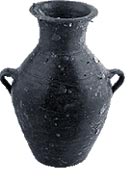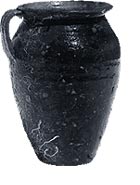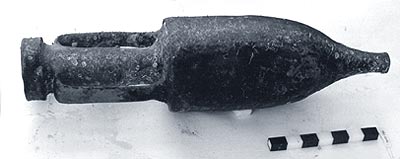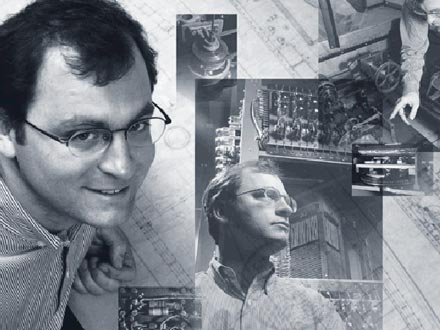Spring 2001
![]()
Soundings is a publication of the School
of Humanities, Arts, and Social Sciences
at MIT
Editor:
Orna
Feldman
Editorial Assistance:
Sue
Mannett
Elisabeth Stark
Layout and Art Direction:
Conquest
Design
Layout and Art Direction:
MIT
Publishing Services Bureau
“Heroism comes down to the relation between people and machinery, between individuals and large technological systems.”
History of Technology Professor David Mindell, amid various computer and
marine innovations.
Photo: Graham G. Ramsay. Courtesy MIT Museum
Crossing boundaries
David Mindell is Frances and David Dibner Associate Professor of the History of Engineering and Manufacturing in the Program in Science, Technology and Society. Recently named a MacVicar Fellow, which honors MIT’s most innovative undergraduate teachers, Mindell teaches and conducts research on the history of control, computing and information processing. Mindell also has been highly involved in developing the technology and methodology for doing archaeology in the deep sea, participating in expeditions in the Black Sea, the Midway Islands, and off the coast of Ashkelon (Israel), and is now collaborating with MIT Sea Grant on developing technologies for archaeological surveys. His 2000 book, War, Technology and Experience aboard the USS Monitor, examines the politics surrounding the Civil War ship and its impact on those who fought.
What is the role of technology in the emerging field of deep sea archaeology?
Some archaeologists insist that the experience of digging is key to what it means to be an archaeologist. Yet in deep water, no human can possibly be there, that is, in the way we’re used to being somewhere. You’re either down in a submarine, which means you can’t stick your hand out the window and pick something up, or you’re many kilometers away looking through a robotic device. To this day we have not excavated a site in deep water with a robot because we don’t know how. We’ve taken pictures and made maps, we’ve recovered some artifacts off the surface of the sea floor, but we have not dug into the sea floor because we don’t think we can yet do that in a responsible way.
What parameters guide you when you consider archaeology in the deep sea?
I’ve been thinking and observing how archaeologists and engineers interact. The questions range from the kinds of technologies you need to who’s going to do the work and what kind of training and resources you need. Early on, engineers were essentially handing the archaeologists a set of tools and the archaeologists were trying to do what they thought those tools did. We’ve tried to reverse that process, asking archaeologists to set the requirements, which forces them to think about their discipline in new ways.
 |
|
|
Photo: Martin Bowen, Woods Hole Oceanographic Institution IFE Clay containers found on a Roman shipwreck, dating to 100 BC. |
What kind of evidence are you looking for?
Traditional archaeology is site oriented, but we’re following newer methodologies interested in landscapes and statistical studies of much broader areas. No one shipwreck site is going to tell us everything we want to know. Rather, I want to see the seafloor as part of a continuous landscape, including ports, hinterland sites, and production sites. When you look at them in the aggregate, for example, you can begin to learn about trade and cultural exchange. Also, the things that interest archaeologists these days are not the king’s cargoes as much as commercial ones—like these ones we found off Ashkelon. They’re not exotic, there isn’t gold on them. They’re old amphoras [ceramic containers], but they reveal a great deal about the economic and cultural infrastructure of the period you’re studying.
How does that theoretical approach translate into the technologies you create?
The technologies you make have everything to do with the assumptions you’re using and how you’re thinking about the problems. We’re working on acoustic sensing technologies, where the goal is to make something like a CAT-scan of a buried shipwreck without ever actually touching it. That allows you to dig in a very localized way, rather than having to dig trenches through a site to find what’s interesting. We hope to model many sites and dig at very few.
What do the shipwrecks you’ve surveyed tell you that people didn’t know before?
In one case—a Phoenician shipwreck from 750 B.C. off the coast of Ashkelon—we found hundreds of amphoras of nearly the exact same size. This suggests that there was well organized market oriented activity going on, where somebody was running a production site. They created a standardized container. They shipped a product across the sea. Once you have that, you have some kind of capital investment. Economic historians previously thought these activities began in large scale in the Roman Empire. Here—and this correlates with other work—we are pushing back the date of organized market activity by several centuries. One of the dominant modes of human life today turns out to have fairly different origins from what people previously thought.
 |
|
| Photo: Brendan Foley, MIT IFE |
What is it about the deep sea that you find particularly fascinating?
It’s a place that’s no place. Out in international waters, the floor of the ocean has almost no legal status. It doesn’t belong to any country. And if you dive down in submarines, you’re sort of there, but you’re sort of not there. Yet the site has a physical reality, which isn’t even very far away. Shipwrecks can be incredibly rich archives of a particular moment, yet at the moment they remain fairly inaccessible.
So, it’s the elusiveness of it?
And the way we’ve used technology to see inside that strange world. We build machines to learn about history—and that’s almost the opposite of what it means to be a historian of technology. It’s also a crossing of borders, but in another direction—using machines to look at history. In both cases, what interests me most is going back and forth between thinking about history and culture and how they change over time, and then thinking about technology and how people build machines.
Let’s segue to your book on the Monitor. How has the notion of heroism changed since Civil War times?
Heroism has to do with crafting individual stories out of a complex, collective world. The sociology of military organizations is often built around the notion that it’s possible to distinguish yourself in war, even if you happen to die. With the Monitor, the people were enclosed in the machine. Many never even saw the enemy. So their very notion of heroism in war was threatened, because it seemed they were merely turning cranks, polishing steam engines, or shoveling coal. On the other hand, the press and the public treated them like heroes. So the Monitor crew had this nagging uncertainty about their own heroic identity. "What’s the big deal about fighting behind 11 inches of armor plate?" they wondered. "Look at those poor slobs running across fields, in front of cannons and bullets, without protection at all." In this industrial war, heroism became not simply facing the enemy, but also facing the sea, and technology itself. Simply surviving in one of these contraptions was considered an accomplishment.
That’s a far cry from Achilles pursuing Hector beneath the walls of Troy.
For me it comes down to the relation between people and machinery, between individuals and large technological systems. I’m interested in how people recover a sense of agency and responsibility in a world of large systems, cyber highways and Internets. The book I’m working on now—about control systems—is very much about power, self, identity.

Photo:
Brendan Foley, MIT IFE
Amphora were antiquity's "55-gallon drums," used to ship and store bulk liquids such as wine and olive oil.
How does Norbert Weiner, an MIT icon, fit into that history?
People give a lot of credit to Norbert Weiner, the MIT math professor who came up with this notion of cybernetics—which he called this new science of control and communication in the animal and the machine. The story is usually told as a kind of origin story, where Weiner has this cybernetic idea, mathematicians design computers and use them as communication devices or tools for human-machine interaction, and the bond between people and machines gradually becomes closer. The trouble [with that view] is that the mathematicians came in at the end of World War II and monopolized the history. Wiener made great contributions, but engineers could often not tell their stories because they were working on secret projects. I’m suggesting an alternate history of computing that’s not one solely of mathematicians and great geniuses. People and machines have always been in some kind of relationship. People build things for different reasons to solve different problems at particular times. I’m trying to connect the history of computers to a much longer history of industry and manufacturing, to see computers as control systems and not just as calculating machines.
Let’s talk about the graduate course, "The Structure of Engineering Revolutions," which you designed.
Basically, there’s a five-year combined bachelor/master program in electrical engineering and computer science. Originally, the fifth year was supposed to be "broadening," but that came to be defined fairly narrowly, as simply more technical topics. Working with the department, we developed a course that uses the history of technology to teach fifth-year students how engineering works in the day-to-day sense. We use something like the "case method" used in business schools, but the students write the cases. By talking to inventors, researchers, and entrepreneurs, they see that the technical problems aren’t always the hardest ones. Making a technology successful requires technical skills, but many other skills as well.
How does this approach help students in their careers?
They learn to be comfortable with navigating between technical and non-technical—and that they too can work across that boundary. Essentially we’re trying to teach engineers that politics, with a small ‘p,’ are everywhere—they’re the social forces at work in a technical situation. We teach them that these are not extraneous or irrational, but that they follow different rationalities from those in science and engineering. These ways of thinking are both learnable and important. The more I teach this way, with the students defining and researching their own problems, the more I’m convinced it’s the right thing to do. When you give MIT students a problem that unleashes their excitement and creativity, they always surprise you.
![]()
Copyright © 2001 Massachusetts
Institute of Technology


